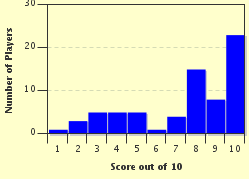Quiz Answer Key and Fun Facts
1. This first Spanish autonomous community is perhaps known for the setting of Cervantes' "Don Quixote". But is also well known for its agricultural crops including olives and grapes, which are famous worldwide. It is also home to Manchego cheese. Famous sites in the area include the old city of Toledo and the Castle of Almansa which is just one of many medieval fortresses in the community. Which community is this?
2. This next autonomy is located directly north of Portugal and borders the Atlantic Ocean. Empanadas are an important local food here, more so than anywhere else in Spain. This region's empanadas are sometimes made like a pie and can be stuffed with octopus, cockles and many other nontraditional fillings. The Santiago de Compostela Cathedral, the burial place of St. James the Great and an important pilgrimage point for Roman Catholics, can be found here. Which autonomous community is this?
3. This autonomy is in the north of Spain and borders France. Perhaps the most famous thing about this autonomy is the Running of the Bulls during the Festival of San Fermin that takes place each July in Pamplona. This place is also one of the greenest places in Europe with over 70% of its electricity generated from the wind. Which autonomous region is this?
4. The autonomous community situated in the Pyrenees also used to be a kingdom. In fact, the highest peak in the Pyrenees, Aneto, can be found here. The region, as you might have guessed, is very mountainous which makes hiking a popular activity in its national parks. The Ordesa y Monte Perdido National Park was home to the Pyrenean ibex before its extinction. Historically speaking, this region is often associated with Castile after the marriage of Ferdinand and Isabella. Which autonomous community is this?
5. Barcelona is the predominant city in this autonomy. However, this region was historically fought over for many years and it wasn't until the 1950s when it really started to grow because of an industrial boom. The area had been decimated during the Napoleonic Wars and Francisco Franco instituted strict measures against the region that essentially eliminated its culture and language until the 1970s. During festivals and events, it is not uncommon to see people form castells, or human towers, which have become synonymous with the region. What autonomy is this?
6. This autonomous community is known for its Paleolithic caves, most famously the Cave of Altamira where the first cave paintings were discovered in 1880. The region also hosts cattle shows, the most famous is the Livestock Fair of Torrelavega. The Winter Carnival called La Vijaera is one of the most popular in Spain. What is this region?
7. This region can be found in the southernmost parts of the Iberian Peninsula and shares a border with Gibraltar. It is also the hottest place in Europe with summer temperatures averaging near 100 degrees Fahrenheit (37.7 degrees Celsius.) The architecture here is influenced by the Moorish culture. The flamenco dance originated here and bullfighting is said to be most popular here than in any other region. Which autonomy is this?
8. This autonomous community has rocky relations with the rest of Spain because of its cultural differences. The separatist group Euskadi Ta Askatasuna was trying to make this region its own nation until a 2011 ceasefire. Culturally, this autonomy is home to a Guggenheim Museum and a Fine Arts museum both in Bilbao. Which contentious autonomous community is this?
9. This autonomous community is probably best known for its scenic national parks including Monfrague, home to many large bird species including vultures. Many conquistadors originated from what is now this region including de Soto, Cortes and Pizarro. Because this region borders Portugal, Portuguese is spoken by a sizeable minority. Which autonomy is this?
10. This autonomous community was the first in Spain to ban bullfighting. It also famous for its observatories, the Teide Observatory and Roque de los Muchachos Observatory. This area was mainly used as a stopping point to the New World during colonial times because the Atlantic winds were easy to follow to here. At one point, there were apparently large dogs roaming around the area, but they may have actually been seals. Which autonomy is this?
Source: Author
Joepetz
This quiz was reviewed by FunTrivia editor
Tizzabelle before going online.
Any errors found in FunTrivia content are routinely corrected through our feedback system.
